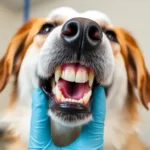
Understanding dog health care is vital for every pet owner, especially when it comes to reproductive health. One breed that is particularly beloved as a family pet is the Golden Retriever. Their friendly demeanor, intelligence, and loyalty make them great companions. However, many new dog owners might be unfamiliar with the reproductive cycle of their female Golden Retrievers, particularly the concept of “heat.”
In this article, we will explore the heat cycle in dogs, focusing on when Golden Retrievers first go into heat and how to manage their care during this time.
Understanding the Heat Cycle in Dogs
What is the Heat Cycle?
The heat cycle, or estrous cycle, is the period during which a female dog is fertile and can conceive. It typically consists of four distinct phases: proestrus, estrus, diestrus, and anestrus.
-
Proestrus: This phase lasts about 9 days and is characterized by swelling of the vulva and a bloody discharge. Females may attract male dogs but will not be receptive to mating.
-
Estrus: Lasting around 5 to 9 days, this is the phase when the female is in heat and can conceive. The discharge may change to a lighter color, and the female will exhibit behaviors indicating she is receptive to males.
-
Diestrus: This phase occurs after estrus and can last about 60 days. The female may either become pregnant or go through a pseudo-pregnancy if not mated.
-
Anestrus: This is the resting phase, lasting several months, where the female’s reproductive system is inactive until the next cycle begins.
Importance of the Heat Cycle
Understanding the heat cycle is crucial for several reasons. Not only does it impact a dog’s behavior, but it also has health implications. Hormonal changes during this cycle can lead to behavioral shifts, such as increased affection or restlessness. Recognizing these signs can help owners manage their pet’s behavior effectively.
When Do Golden Retrievers First Go Into Heat?
Average Age of First Heat
Golden Retrievers typically experience their first heat between the ages of 6 to 12 months. However, this can vary based on several factors:
- Genetics: The lineage of a dog can influence when it reaches sexual maturity.
- Size: Smaller breeds often go into heat earlier than larger breeds, which can delay the onset of the first heat.
- Overall Health: A healthy dog may enter heat earlier than one that is not in optimal condition.
Signs of First Heat
As a Golden Retriever approaches her first heat, several physical and behavioral signs may become apparent:
-
Physical Signs: Look for swelling of the vulva, which may be accompanied by a bloody discharge. This is a clear indication that the dog is in proestrus and nearing estrus.
-
Behavioral Changes: Owners may notice increased affection, restlessness, or even attempts to escape to find male dogs. These behaviors are often a result of hormonal changes.
Managing a Golden Retriever in Heat
Preparing for Heat
When a Golden Retriever goes into heat, preparation is key. Here are some tips for pet owners:
- Doggy Diapers: Consider using doggy diapers to manage discharge and maintain cleanliness in your home.
- Maintaining Hygiene: Regular baths and keeping the area around the vulva clean can help prevent infections.
Behavioral Management
A female Golden Retriever in heat may exhibit heightened emotions and behaviors. Here are some strategies for managing these changes:
- Training Tips: Reinforce basic commands to ensure good behavior. Positive reinforcement can help mitigate any unwanted actions.
- Provide Distractions: Engage your dog in stimulating activities to redirect excess energy. Puzzle toys or extra playtime can help keep her occupied.
Health Considerations
Regular veterinary check-ups are crucial during this period to monitor your dog’s health. Here are a few health considerations:
- Infections: Be aware of signs of infection, such as excessive discharge, foul odor, or signs of discomfort.
- Complications: If you notice any unusual changes in behavior or health, consult your veterinarian promptly.
Spaying: Pros and Cons
What is Spaying?
Spaying is the surgical procedure that removes a female dog’s ovaries and usually the uterus. This process is considered a responsible choice for many pet owners.
Reasons to Spay a Golden Retriever
There are numerous benefits to spaying a Golden Retriever:
-
Preventing Unwanted Litters: Spaying eliminates the risk of unplanned pregnancies, which can lead to overpopulation.
-
Health Benefits: Spaying can significantly reduce the risk of certain cancers, such as ovarian and uterine cancer, and can also help prevent infections like pyometra.
Potential Downsides
While spaying has many advantages, there are potential downsides to consider:
-
Surgical Risks: As with any surgery, there are risks involved, including reactions to anesthesia and post-operative complications.
-
Timing and Health: The timing of the spay surgery can impact health. It’s essential to discuss with your veterinarian the best timing based on your dog’s age, health, and breed characteristics.
Health Care Tips for Golden Retrievers
Regular Vet Check-ups
Routine veterinary visits are essential for maintaining your Golden Retriever’s health. Regular check-ups help catch potential health issues early and ensure vaccinations are up to date.
Nutrition and Diet
Proper nutrition is critical, especially during a dog’s reproductive phases. Ensure that your Golden Retriever receives a balanced diet rich in nutrients. Consult your veterinarian for specific dietary recommendations tailored to her needs.
Exercise and Mental Stimulation
Golden Retrievers are active dogs that require regular exercise to maintain both physical and mental health. Here are some tips:
- Daily Walks: Aim for at least an hour of exercise each day, which can include walks, playtime, or swimming.
- Mental Activities: Engage your dog with training sessions or interactive toys that challenge her mind.
Conclusion
Understanding when Golden Retrievers first go into heat is an essential aspect of responsible pet ownership. Recognizing the signs of heat, preparing for the changes, and knowing how to manage your dog’s health care during this time can greatly enhance your dog’s well-being.
Whether you choose to spay or not, it’s crucial to consult with your veterinarian for personalized advice and care. By being proactive in your dog’s health care, you can ensure a happy, healthy life for your beloved Golden Retriever.









